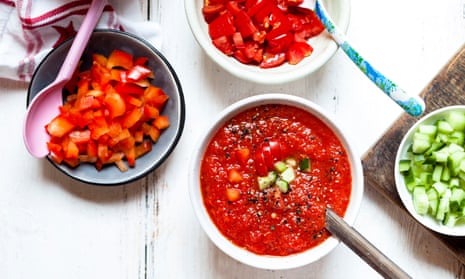Wounds Jamie Oliver inflicted three years ago when he added chorizo to rice and called it paella remain raw, while hopes of an end to the war over whether onions belong in a tortilla de patatas seem as forlorn as ever.
But as Spain endures a particularly sweltering summer, the debate has turned to the country’s best-known antidote to the heat and, specifically, the question of whether cucumber has any place in a deliciously cooling bowl of gazpacho.
The row began, not unpredictably, on Twitter. At the end of July the Spanish comedian known as El Monaguillo (the altar boy; real name Sergio Fernández Meléndez) conducted his own poll. “Really important survey,” he wrote. “Gazpacho with cucumber or without cucumber?”
Of the 3,809 people who replied, 63% were in favour of adding cucumber to the cold Andalucían soup. Others felt differently – some vehemently so.
“Cucumber in gazpacho is gastronomic terrorism!” said Dani García, a chef who runs a three-Michelin-star restaurant and who, like his friend El Monaguillo, is from Andalucía.
When another Twitter user had the temerity to remind García that he was famous for his recipe for cherry gazpacho, the chef replied: “Are you really comparing the elegance of a cherry to the aggressiveness of a cucumber?”
The issue has prompted long and thoughtful pieces in the Spanish press, and churned up another familiar culinary controversy.
Charo Barrios, president of the Academy of Andalucían Gazpacho, insists people can put whatever vegetables they like into the soup, and says cucumber is not the only disputed ingredient. “Cucumber’s definitely an option, but there are other debates as well, like whether you add bread,” she says. “Bread gives the soup a different texture and means you’re adding carbohydrates. And then there’s the debate over adding water. It depends on the quality of the tomatoes, but if they’re not great, it could end up too watery. I think it’s more about bread than cucumber, but we think you can add whatever you want, from other vegetables to fruit.”
Barrios keeps thing simple and proudly Andalucían. “I make it with a tiny bit of garlic, onion, half a cucumber, one or two green peppers, tomatoes, good salt, sherry vinegar and good extra virgin olive oil.”
García told the Observer that while his tweets were tongue in cheek, he could not abide the disruptive feistiness of cucumber in gazpacho. His epiphany came in the late 1990s, when he elevated the humble soup into a dish for the high-end restaurant where he was working.
“The first one I made that was a little out of the ordinary was a cherry gazpacho – even though it was based on a traditional recipe, for raspberry gazpacho,” he said. “When I made it, I couldn’t find a way to balance the cucumber because it’s one of those ingredients that I call invasive. No matter how much you try to balance it out, it’s a taste that just keeps on punching through. I wanted it to be tomato and cherry on people’s palates, not cucumber. So in 1998, I just went, ‘That’s it – bye bye cucumber!’.”
When most people thought of gazpacho, he added, they thought of a simple tomato soup with cucumber, peppers, garlic, olive oil, vinegar and bread. “But, historically, a gazpacho can be many things: a white gazpacho [with garlic and almonds] is ajo blanco, a green one is made with green tomatoes and an orange one is made with bitter oranges. There are as many gazpacho recipes as there are people: it’s all about how you make it at home.”
Fernando Huidobro, president of the Andalucían Academy of Gastronomy and Tourism, laughed off the idea of people getting hung up on a single ingredient. “The oldest, most original recipes for gazpacho are fairly anarchic,” he said. “It was a way for country people to feed themselves: ‘What can I eat easily to get me through my work? I’ve got water, I’ve got oil, I’ve got garlic and I’ve got vinegar. If I’ve got bread, I’ll put bread in’.” It was only later, when people started adding tomato, that the more “official” recipe was born, said Huidobro, adding that the soup had traditionally been made cold, with oranges in the absence of tomatoes, or hot if people were lucky enough to have some partridge.
“Each family can add cucumber if they want, just like you can put in onion – which is an atrocity as far as the purists are concerned,” he said. “But I think Dani’s right: cucumber is invasive and tends to take over. It’s a family matter at the end of the day. It’s a basic thing that was originally made with whatever you had to hand – that’s what made it unique. It really is as awfully simple as that.”
You say patatas …

Spaniards seems to enjoy bickering over how their food should, or shouldn’t, be prepared. Jamie Oliver was threatened and insulted when he included chorizo in a “paella” recipe in 2016. “Remove the chorizo,” ordered one. “We don’t negotiate with terrorists.”
The chef could have just called the dish arroz con cosas (rice with stuff), rather than the more sacrosanct label. The most perennial debate, however, is over onion in a tortilla, which pits concebollistas (with-onionists) against sincebollistas (without-onionists), and is complicated by the equally personal issue of how long a tortilla should be cooked for. Some prefer it barely set so it oozes eggy puddles when cut, while others like a drier, firmer omelette.
